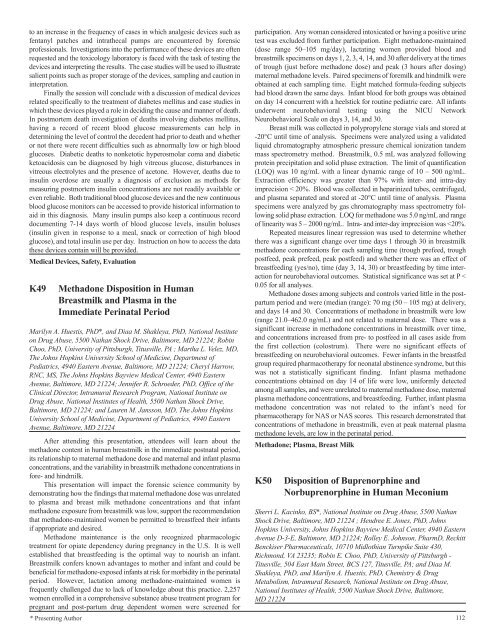FORENSIC TOXICOLOGY - Bio Medical Forensics
FORENSIC TOXICOLOGY - Bio Medical Forensics
FORENSIC TOXICOLOGY - Bio Medical Forensics
Create successful ePaper yourself
Turn your PDF publications into a flip-book with our unique Google optimized e-Paper software.
to an increase in the frequency of cases in which analgesic devices such as<br />
fentanyl patches and intrathecal pumps are encountered by forensic<br />
professionals. Investigations into the performance of these devices are often<br />
requested and the toxicology laboratory is faced with the task of testing the<br />
devices and interpreting the results. The case studies will be used to illustrate<br />
salient points such as proper storage of the devices, sampling and caution in<br />
interpretation.<br />
Finally the session will conclude with a discussion of medical devices<br />
related specifically to the treatment of diabetes mellitus and case studies in<br />
which these devices played a role in deciding the cause and manner of death.<br />
In postmortem death investigation of deaths involving diabetes mellitus,<br />
having a record of recent blood glucose measurements can help in<br />
determining the level of control the decedent had prior to death and whether<br />
or not there were recent difficulties such as abnormally low or high blood<br />
glucoses. Diabetic deaths to nonketotic hyperosmolar coma and diabetic<br />
ketoacidosis can be diagnosed by high vitreous glucose, disturbances in<br />
vitreous electrolytes and the presence of acetone. However, deaths due to<br />
insulin overdose are usually a diagnosis of exclusion as methods for<br />
measuring postmortem insulin concentrations are not readily available or<br />
even reliable. Both traditional blood glucose devices and the new continuous<br />
blood glucose monitors can be accessed to provide historical information to<br />
aid in this diagnosis. Many insulin pumps also keep a continuous record<br />
documenting 7-14 days worth of blood glucose levels, insulin boluses<br />
(insulin given in response to a meal, snack or correction of high blood<br />
glucose), and total insulin use per day. Instruction on how to access the data<br />
these devices contain will be provided.<br />
<strong>Medical</strong> Devices, Safety, Evaluation<br />
K49 Methadone Disposition in Human<br />
Breastmilk and Plasma in the<br />
Immediate Perinatal Period<br />
Marilyn A. Huestis, PhD*, and Diaa M. Shakleya, PhD, National Institute<br />
on Drug Abuse, 5500 Nathan Shock Drive, Baltimore, MD 21224; Robin<br />
Choo, PhD, University of Pittsburgh, Titusville, PA ; Martha L. Velez, MD,<br />
The Johns Hopkins University School of Medicine, Department of<br />
Pediatrics, 4940 Eastern Avenue, Baltimore, MD 21224; Cheryl Harrow,<br />
RNC, MS, The Johns Hopkins Bayview <strong>Medical</strong> Center, 4940 Eastern<br />
Avenue, Baltimore, MD 21224; Jennifer R. Schroeder, PhD, Office of the<br />
Clinical Director, Intramural Research Program, National Institute on<br />
Drug Abuse, National Institutes of Health, 5500 Nathan Shock Drive,<br />
Baltimore, MD 21224; and Lauren M. Jansson, MD, The Johns Hopkins<br />
University School of Medicine, Department of Pediatrics, 4940 Eastern<br />
Avenue, Baltimore, MD 21224<br />
After attending this presentation, attendees will learn about the<br />
methadone content in human breastmilk in the immediate postnatal period,<br />
its relationship to maternal methadone dose and maternal and infant plasma<br />
concentrations, and the variability in breastmilk methadone concentrations in<br />
fore- and hindmilk.<br />
This presentation will impact the forensic science community by<br />
demonstrating how the findings that maternal methadone dose was unrelated<br />
to plasma and breast milk methadone concentrations and that infant<br />
methadone exposure from breastmilk was low, support the recommendation<br />
that methadone-maintained women be permitted to breastfeed their infants<br />
if appropriate and desired.<br />
Methadone maintenance is the only recognized pharmacologic<br />
treatment for opiate dependency during pregnancy in the U.S. It is well<br />
established that breastfeeding is the optimal way to nourish an infant.<br />
Breastmilk confers known advantages to mother and infant and could be<br />
beneficial for methadone-exposed infants at risk for morbidity in the perinatal<br />
period. However, lactation among methadone-maintained women is<br />
frequently challenged due to lack of knowledge about this practice. 2,257<br />
women enrolled in a comprehensive substance abuse treatment program for<br />
pregnant and post-partum drug dependent women were screened for<br />
* Presenting Author<br />
participation. Any woman considered intoxicated or having a positive urine<br />
test was excluded from further participation. Eight methadone-maintained<br />
(dose range 50–105 mg/day), lactating women provided blood and<br />
breastmilk specimens on days 1, 2, 3, 4, 14, and 30 after delivery at the times<br />
of trough (just before methadone dose) and peak (3 hours after dosing)<br />
maternal methadone levels. Paired specimens of foremilk and hindmilk were<br />
obtained at each sampling time. Eight matched formula-feeding subjects<br />
had blood drawn the same days. Infant blood for both groups was obtained<br />
on day 14 concurrent with a heelstick for routine pediatric care. All infants<br />
underwent neurobehavioral testing using the NICU Network<br />
Neurobehavioral Scale on days 3, 14, and 30.<br />
Breast milk was collected in polypropylene storage vials and stored at<br />
-20°C until time of analysis. Specimens were analyzed using a validated<br />
liquid chromatography atmospheric pressure chemical ionization tandem<br />
mass spectrometry method. Breastmilk, 0.5 mL was analyzed following<br />
protein precipitation and solid phase extraction. The limit of quantification<br />
(LOQ) was 10 ng/mL with a linear dynamic range of 10 – 500 ng/mL.<br />
Extraction efficiency was greater than 97% with inter- and intra-day<br />
imprecision < 20%. Blood was collected in heparinized tubes, centrifuged,<br />
and plasma separated and stored at -20°C until time of analysis. Plasma<br />
specimens were analyzed by gas chromatography mass spectrometry following<br />
solid phase extraction. LOQ for methadone was 5.0 ng/mL and range<br />
of linearity was 5 – 2000 ng/mL. Intra- and inter-day imprecision was






